
The 2002 United States House of Representatives elections were held on November 5, 2002, in the middle of President George W. Bush's first term, to elect U.S. Representatives to serve in the 108th United States Congress. This was the first congressional election using districts drawn up during the 2000 United States redistricting cycle on the basis of the 2000 census.

The 1932 United States House of Representatives elections were elections for the United States House of Representatives to elect members to serve in the 73rd United States Congress. They were held for the most part on November 8, 1932, while Maine held theirs on September 12. They coincided with the landslide election of President Franklin D. Roosevelt.
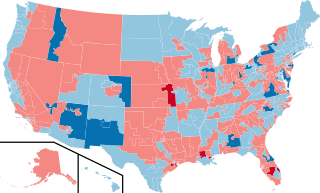
The 2008 United States House of Representatives elections were held on November 4, 2008, to elect members to the United States House of Representatives to serve in the 111th United States Congress from January 3, 2009, until January 3, 2011. It coincided with the election of Barack Obama as president. All 435 voting seats, as well as all 6 non-voting seats, were up for election. The Democratic Party, which won a majority of seats in the 2006 election, expanded its control in 2008.
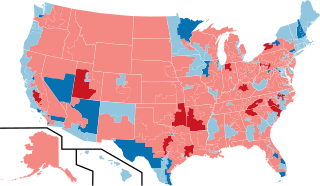
The 2012 United States House of Representatives elections were held on November 6, 2012. It coincided with the reelection of President Barack Obama. Elections were held for all 435 seats representing the 50 U.S. states and also for the delegates from the District of Columbia and five major U.S. territories. The winners of this election cycle served in the 113th United States Congress. This was the first congressional election using districts drawn up based on the 2010 United States census.
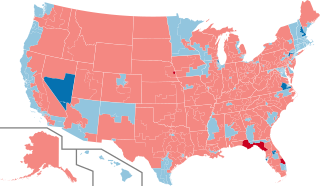
The 2016 United States House of Representatives elections were held on November 8, 2016, to elect representatives for all 435 congressional districts across each of the 50 U.S. states to the 115th United States Congress. Non-voting members for the District of Columbia and territories of the United States were also elected. These elections coincided with the election of President Donald Trump, although his party lost seats in both chambers of Congress. The winners of this election served in the 115th Congress, with seats apportioned among the states based on the 2010 United States census. In October 2015, the House elected a new Speaker, Republican Paul Ryan, who was re-elected in the new term. Democrat Nancy Pelosi continued to lead her party as Minority Leader. Elections were also held on the same day for the U.S. Senate, many governors, and other state and local elections.

The 2018 United States House of Representatives elections were held on November 6, 2018, as part of the 2018 midterm elections during President Donald Trump's term, with early voting taking place in some states in the weeks preceding that date. Voters chose representatives from all 435 congressional districts across each of the 50 U.S. states to serve in the 116th United States Congress. Non-voting delegates from the District of Columbia and four of the five inhabited U.S. territories were also elected. On Election Day, Republicans had held a House majority since January 2011.
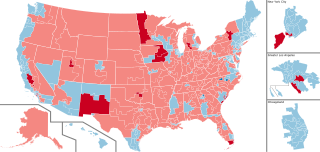
The 2020 United States House of Representatives elections were held on November 3, 2020, to elect representatives from all 435 congressional districts across each of the 50 U.S. states to the 117th United States Congress, as well as six non-voting delegates from the District of Columbia and the inhabited U.S. territories. Special House elections were also held on various dates throughout 2020.
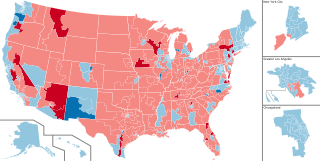
The 2022 United States House of Representatives elections were held on November 8, 2022, as part of the 2022 United States elections during incumbent president Joe Biden's term. Representatives were elected from all 435 U.S. congressional districts across each of the 50 states to serve in the 118th United States Congress, as well as 5 non-voting members of the U.S. House of Representatives from the District of Columbia and four of the five inhabited insular areas. Numerous other federal, state, and local elections, including the 2022 U.S. Senate elections and the 2022 U.S. gubernatorial elections, were also held simultaneously. This was the first election after the 2020 redistricting cycle.

The 2020 Minnesota Senate election was held in the U.S. state of Minnesota on November 3, 2020, to elect members to the Senate of the 92nd Minnesota Legislature. A primary election was held in several districts on August 11, 2020. The election coincided with the election of the other house of the Legislature, the House of Representatives, and other elections.

The 2020 Minnesota House of Representatives election was held in the U.S. state of Minnesota on November 3, 2020, to elect members to the House of Representatives of the 92nd Minnesota Legislature. A primary election was held in several districts on August 11, 2020. The election coincided with the election of the other house of the Legislature, the Senate, and other elections.

The Wisconsin State Assembly elections of 2020 were held on Tuesday, November 3, 2020. All 99 seats in the Wisconsin State Assembly were up for election. 13 incumbent Assembly members filed papers declaring that they would not run for re-election, including two who announced early vacancies. Right before this election, 63 Assembly seats were held by Republicans, 34 seats were held by Democrats, and two seats were vacant.

The 2020 Oklahoma House of Representatives election took place as part of the biennial 2020 United States state legislative elections. Oklahoma voters elected state representatives in all 101 House districts. State Representatives serve two-year terms in the Oklahoma House of Representatives.

Elections to the North Dakota House of Representatives were held on November 3, 2020. A total of 46 seats out of 94 were up for re-election.

The 2022 Iowa Senate elections were held on November 8, 2022, to elect members of the Iowa Senate from 25 odd-numbered districts. Senators serve four-year terms in single-member constituencies, with half of the seats up for election each cycle. Primary elections were held on June 7.

The 2022 Colorado House of Representatives elections took place on November 8, 2022, along with the elections in the State Senate. The primary elections were held on June 28, 2022. Voters in all 65 districts of the state House elected their representative for a two-year term. These coincided with other Colorado elections of the same year and the biennial United States elections.

The 2022 Tennessee House of Representatives election was held on November 8, 2022, to elect 99 seats for the Tennessee House of Representatives. The elections coincided with the Governor, U.S. House, and State Senate elections.

The 2022 North Dakota Senate elections were held on November 8, 2022, as part of the biennial 2022 United States elections. 32 of the seats in the North Dakota State Senate were up for election. Primary elections were held on June 14, 2022. The elections coincided with elections for other offices in North Dakota, including the US Senate, US House, North Dakota Secretary of State, North Dakota Attorney General, and the North Dakota House of Representatives.

The 2022 South Dakota House of Representatives elections were held on November 8, 2022, as part of the biennial 2022 United States elections. All 70 seats in the South Dakota House of Representatives were up for election. Primary elections were held on June 7, 2022. The elections coincided with elections for other offices in South Dakota, including the US Senate, US House, South Dakota Governor, South Dakota Secretary of State, South Dakota Attorney General, and the South Dakota Senate.

The 2022 Maryland House of Delegates election was held on November 8, 2022, electing all 141 members of the chamber. This coincided with the election of all 47 of Maryland's state senators, along with other statewide offices. The Democratic and Republican primaries were held on July 19, 2022.

The 2024 United States House of Representatives elections will be held on November 5, 2024, as part of the 2024 United States elections, to elect representatives from all 435 congressional districts across each of the 50 U.S. states, as well as 6 non-voting delegates from the District of Columbia and the inhabited U.S. territories. Special elections may also be held on various dates throughout 2024. Numerous other federal, state, and local elections, including the U.S. presidential election and elections to the Senate, will also be held on this date. The winners of this election will serve in the 119th United States Congress, with seats apportioned among the states based on the 2020 United States census.






















